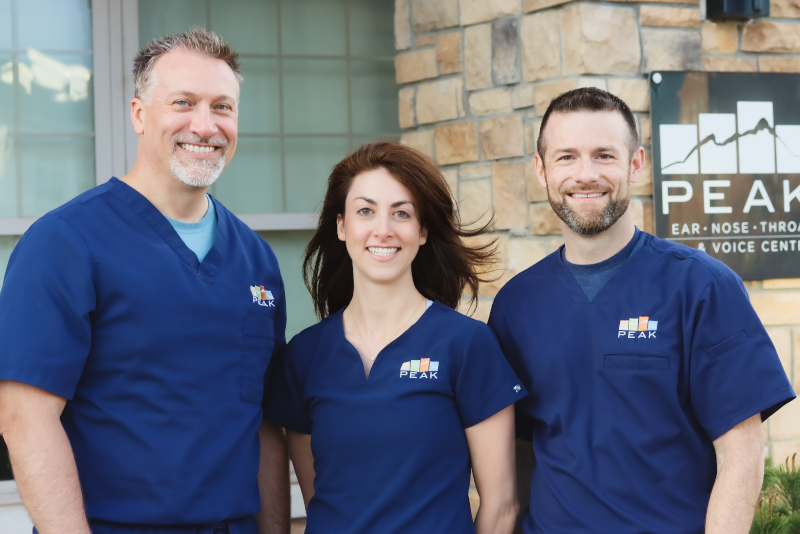Head and Neck Specialists
Home » Denver Head Neck Clinic
Neck or Gland Issues & Problems | Colorado ENT Doctor

Our PEAK ENT specialists treat a variety of benign and cancerous head and neck problems. We specialize in the diagnosis, assessment, and medical and/or surgical management of disorders affecting the head and neck. Common problems we see involve lesions in the nose/sinuses, mouth, lips, tongue, tonsils and throat. Our providers are frequently consulted to manage masses or growths in the neck including lymph nodes, thyroid nodules/cancers and salivary gland tumors. Dr. King specializes in the treatment of benign and malignant vocal cord and tracheal lesions.
Our providers at Peak ENT provide state of the art non-invasive endoscopy equipment to be able to frequently diagnose many problems in the office. All of our providers have a wealth of experience diagnosing and managing a variety of head and neck disorders, and we understand how stressful the uncertainty of such problems can be for patients and their families. Rest assured, our team of health care professionals will help you find answers and collaborate together on best options to treat your symptoms.
Our Head & Neck Department

What causes a lump in the neck?
There is a long list of potential causes for a mass in the neck. A thorough history and physical examination by an ENT doctor can often help narrow down this list. Some of the more common lumps we see are:
Enlarged lymph node. The most common cause of an enlarged lymph node is reactive adenopathy, meaning the lymph node, which is part of the immune system, is growing simply as a reaction to a source of inflammation. In the neck, this may be due to inflammation or infection in the tonsils or other areas of the throat, teeth, gums, or skin. If a source of infection is identified, often a course of antibiotics will help reduce the swollen lymph node. If infection is ruled out, or the lymph node does not respond to treatment for an infection, we must consider other more serious causes. A cancer of the throat, salivary glands, thyroid gland, or skin may spread to lymph nodes in the neck. Sometimes the enlarged lymph node is the first sign of an underlying cancer, which may have existed for some time already without causing symptoms. A cancer of the lymph node itself, called lymphoma, can also occur.
Thyroid nodule. A thyroid nodule causes a lump in the lower neck that moves up and down with swallowing. These may or may not be associated with abnormalities in the thyroid’s function (such as under- or overactive thyroid). Most thyroid nodules (about 90%) are benign, but additional testing is typically recommended to rule out a thyroid cancer.
Salivary gland mass. A growth of one of the salivary glands can cause a lump that is felt in front of or below the ear, or under the jaw bone. The majority of these growths are benign, but additional testing and sometimes surgery is generally needed to exclude a cancer.
Congenital cysts. Some cysts that are due to a congenital problem may in fact not become apparent until adulthood. These include branchial cleft cysts as well as thyroglossal duct cysts. The recommended treatment for these cysts is usually surgery to remove the cyst.
What will be done to investigate a lump in the neck?
Your ENT physician will first perform a thorough history and physical exam. This may include a fiberoptic laryngoscopy if an underlying throat disorder is suspected. Depending on the level of concern at this point, additional testing may be recommended. An imaging study such as ultrasound, CT scan, or in some cases MRI may be necessary. A biopsy of the mass can often be performed initially with a needle. This is called fine needle aspiration and obtains a sample of cells from the mass to be examined by a pathologist. This may be performed either in the office by the ENT physician, or under ultrasound guidance by an interventional radiologist. Finally, depending on the results of this testing, surgery to remove the mass may be recommended. Often, surgery is the most definitive way to rule out a cancer.

The thyroid is a gland located in the lower portion of the neck, just below your voice box. It is butterfly-shaped, with a lobe of tissue sitting on each side of the trachea (wind pipe) connected by a narrower isthmus resting on the front of the trachea. This gland secretes thyroxine (T4) and triiodothyronine (T3), collectively referred to as thyroid hormone, into the bloodstream. Thyroid hormone helps regulate metabolism in a variety of tissues throughout the body.
Thyroid nodules may be benign (most common) or cancerous (10% of nodules). Further evaluation of the nodule will be needed to determine which of these categories it belongs to. Generally, a thyroid ultrasound will be ordered as well as bloodwork to evaluate for an under- or overactive thyroid gland.
Nodules that are small or appear benign on ultrasound may be followed by obtaining another ultrasound several months later. Based on certain criteria on ultrasound, such as size of the nodule, consistency of the nodule (solid or fluid-filled), and presence of other findings like increased blood flow or presence of calcifications, a biopsy may be recommended. Typically a biopsy will first involve a minor procedure known as ultrasound-guided fine needle aspiration. This procedure allows a sampling of cells from the nodule for analysis. The biopsy may show the nodule to be benign, malignant, or varying degrees of abnormal in between. In some cases, additional genetic testing on a needle biopsy can be performed to help predict how likely the nodule is to be cancerous. This additional testing can be useful in cases when the initial biopsy is reported as abnormal, but not definitely cancerous.
If a thyroid nodule is thought to have a high likelihood of being cancerous, or if the nodule is large enough to cause symptoms, surgery to remove part or all of the thyroid gland may be recommended.
The physicians at Peak ENT are experienced in managing thyroid nodules and performing thyroid surgery, and will guide you through every step in the diagnosis and decision making process.

Thyroid cancers are usually first detected as a lump in the neck, or thyroid nodule. In some cases, the nodule can be diagnosed as cancerous with a simple needle biopsy. In other cases, a diagnosis of cancer cannot be made without definitive surgical removal of the nodule. The primary mode of treatment for thyroid cancer is surgery to remove the cancer and thyroid gland, as well as any involved areas of lymph nodes. In more advanced tumors, it may be recommended to remove certain areas of lymph nodes even when there is no obvious tumor present in the nodes. Additional treatment after surgery such as radioactive iodine may be recommended in certain cases, especially for more advanced cancers.
The physicians at Peak ENT are experienced in the surgical treatment of thyroid cancer and will work along with the rest of your treatment team to ensure the most successful outcome possible.
For additional information about thyroid cancer and its treatment, see this educational booklet, Thyroid Cancer Basics, which is provided by the Thyroid Cancer Survivors’ Association.

Tumors of the salivary glands
Benign and malignant tumors can occur in any of the major and minor salivary glands. The most common location for these tumors is the parotid gland. Generally, the bigger the gland in which the tumor occurs, the more likely the tumor is to be benign. Over 80% of parotid tumors, for example, are benign. In contrast, the majority of tumors that originate from the minor salivary glands are cancerous. Treatment for both benign and cancerous tumors of the salivary glands is surgery to remove the tumor. More aggressive surgery is needed for cancerous tumors than for benign tumors, and may also involve removal of certain areas of lymph nodes in the neck. Testing prior to surgery can help guide treatment, and will likely include an imaging study such as CT or MRI, as well as a biopsy of the tumor.
Salivary gland stones: Sialolithiasis
Salivary stones, or sialoliths, most commonly occur from the submandibular glands, though can also occur with the parotid glands. When large enough, these stones can block the drainage of all or part of the associated gland. This results in swelling and pain of the gland, which often worsens during eating. The poor drainage of the gland can also lead to infection of the gland, called sialadenitis. Smaller stones that are lodged in the duct of the gland can often be removed through the mouth, even under local anesthesia in many cases. Very large or multiple stones, or stones that are lodged in the gland itself, may require surgery to remove the entire gland.
Salivary gland infection: Sialadenitis
Infection of the parotid or submandibular salivary glands can occur, causing severe swelling and pain of the affected gland, as well as a fever in some cases. These infections can become severe and even life-threatening in some cases. Infections typically occur in glands that do not drain properly, such as with salivary stones, dehydration or certain medications causing thickening of the saliva, or autoimmune conditions affecting the function of the salivary glands. Infections typically respond to a combination of antibiotics, good hydration, massage of the gland, and items such as sugar-free sour candy to stimulate salivary flow. For recurring infections of the same gland, surgery to remove the gland may be needed.
Sjogren’s Syndrome
Sjogren’s syndrome is an autoimmune disorder causing chronic inflammation and destruction of salivary and other glandular tissue. Typical symptoms include chronic dry mouth and dry eye. Sjogren’s syndrome can occur alone or in association with other autoimmune conditions such as lupus or rheumatoid arthritis. ENT physicians may become involved with the diagnosis of this condition by sampling some minor salivary gland tissue as a biopsy. This is a minor procedure that can be performed with minimal discomfort under local anesthesia.
The physicians of Peak ENT are experienced in the medical and surgical management of salivary gland disorders, including surgery to remove the salivary glands.

Meet the Team

